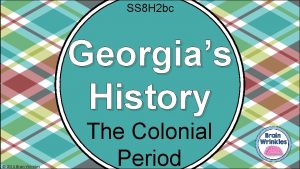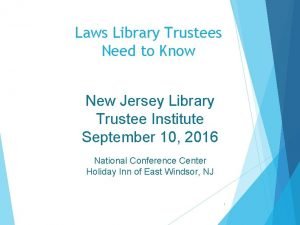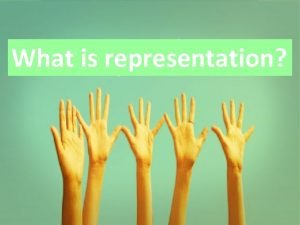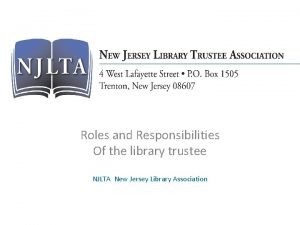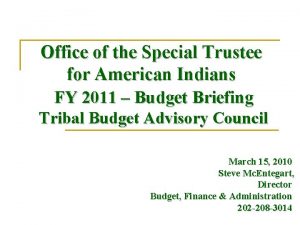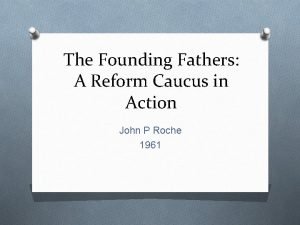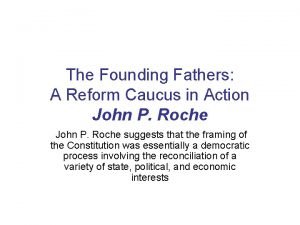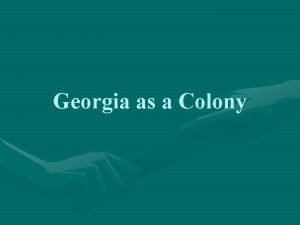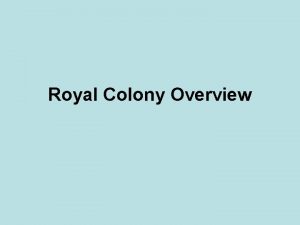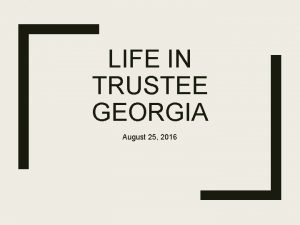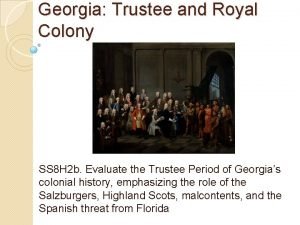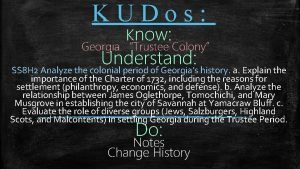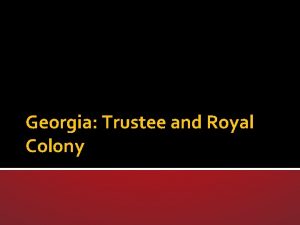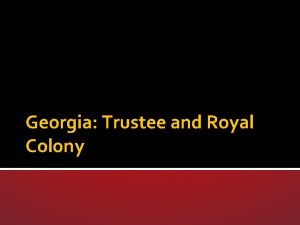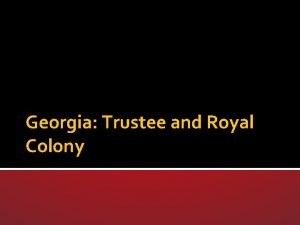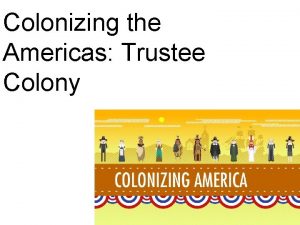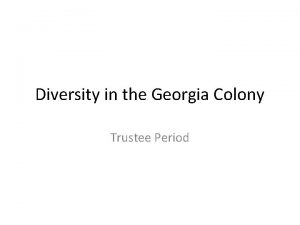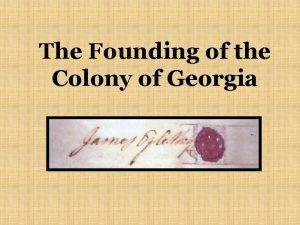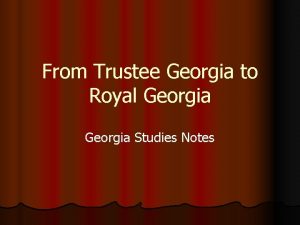FOUNDING OF THE GEORGIA COLONY From a Trustee

















- Slides: 17

FOUNDING OF THE GEORGIA COLONY From a Trustee Colony to a Royal Colony

WORDS TO KNOW Philanthropic - seeking to promote the welfare of others, especially by donating money to good causes; generous and benevolent. Charter – a document which outlines the rights and privileges of an institution or body. Trustee - an individual person or member of a board given control or powers of administration of property in trust with a legal obligation to administer it solely for the purposes specified. Interpreter - a person who interprets, especially one who translates speech orally. Buffer - a person or thing that prevents incompatible or antagonistic people or things from coming into contact with or harming each other. Colony - a country or area under the full or partial political control of another country, typically a distant one, and occupied by settlers from that country. Malcontent - a person who is dissatisfied and rebellious.

MOTIVATING FACTORS FOR THE FOUNDING OF GA 1. Philanthropic: To provide relief for the “worthy poor” (charity) 2. Economic: Self-supporting colony to provide cheap natural resources for Britain 3. Defensive: A protective barrier barrie (buffer) between Florida and the settlement of Charles Town (South Carolina) *Note: Georgia was not set up as a debtor colony nor was James Oglethorpe the primary founder or official governor. He was but one of 21 Trustees charged with governing the colony and was the resident trustee.

THE COLONY OF GEORGIA In 1732, King George II granted a Charter to the Trustees of Georgia to create and oversee the newly approved Georgia colony. James Oglethorpe and 20 other gentlemen were to oversee the colony for 21 years No Trustee could own land in Georgia, nor could they make any profit off of the new colony This was done to insure that the most just decisions were made for the colony, not influenced by monetary gain James Oglethorpe was the only Trustee to visit or live in the GA Colony In 1734, James Oglethorpe took Chief Tomochichi and several other Yamacraw to England to meet the Trustees Oglethorpe and Tomochichi were very close friends until the Chief’s death in 1739 This friendship helped the Georgia colony have an easier beginning than other British colonies

THE YAMACRAW MEET THE TRUSTEES

IMPORTANT PEOPLE AND LOCATIONS James Oglethorpe was granted the Charter of 1732 by King George II for unclaimed land between SC and FL. It became official on February 12, 1733 Oglethorpe argued for colonists’ rights and championed the idea of a new colony for the “worthy poor” He was the only resident trustee of the Georgia colony and fought the Florida Spanish In 1775, he refused to lead the British Army against America, advocating compromise instead Tomochichi was the Chief of the Yamacraw Indians and an important ally for Oglethorpe He played a role as advisor and peacemaker between Europeans and Native Americans

IMPORTANT PEOPLE AND LOCATIONS Mary Musgrove (Coosaponakessa) was known as an interpreter and a peacmaker She was the daughter of an English trader and a Creek Indian woman She used her English and Creek connections to broker peace in the Georgia Colony

THE SAVANNAH COLONY Savannah, founded in 1733, was the last British colonial capital It was designed during the same time and used some of the same ideas about cities and buildings as European cities like Paris Savannah’s neighborhoods are still connected by squares of equal size in a repeating pattern with public lands called commons

THE SAVANNAH COLONY Each colonist was given an equal amount of land in town, and a garden plot outside of town in which they were expected to grow mulberry trees to support the silk industry.

IMPORTANT GROUPS AND THREATS Salzburgers: Protestants who were expelled from Salzburg, Austria in the early 1730 s Georgia’s trustees and King George II supported and invited them to move to Georgia and to settle in the town of Ebenezer Highland Scots arrived in St. Simons Island from Inverness Scotland in 1735 They founded New Inverness later named Darien, 60 miles south of Savannah They were fine soldiers recruited by Oglethorpe to provide a buffer between the English Colony and the Spanish in Florida They played a critical role in helping Oglethorpe defeat the Spanish and to secure English claims in North America Malcontents – Highlanders that settled in Darien and were members of Clan Chanttan in Scotland They were not aided by the trustees because they were wealthy enough to pay for their own voyage to Georgia For this reason, they were not loyal to the trustees or Great Britain

AUSTRIAN SALZBURGERS & HIGHLAND SCOTS

SPANISH THREATS IN FLORIDA The Spanish were a threat to the new settlers in Georgia From Fort Fredirica, Georgia, soldiers made unsuccessful attacks on Spanish missions in St. Augustine, Florida Tensions between the Spanish (FL) and British (GA) resulted in the Battle of Bloody Marsh The Spanish retreated and never attacked the British on the

CHANGES IN THE COLONY James Oglethorpe left the colony of Georgia for the last time in 1743 In the years that followed, the arguments of the Malcontents grew stronger in regards to the following limitations in Georgia The inability to buy or sell more land The inability to produce and sell rum The inability to own and use slaves The Malcontents saw how wealthy those in the Carolinas and Virginia were becoming, and they fought with the Trustees to remove the above mentioned restrictions In 1752, the Trustees returned control over the colony to King George II and Georgia became a Royal colony

ROYAL GOVERNORS John Reynolds First Royal Governor (1754 – 1757) Tenure began around the time of the French and Indian War Ineffective leader Lord Halifax removed him from governorship at request of colonists Henry Ellis Appointed by Lord Halifax (1757 -1760) Built forts and tried to abolish slavery Befriended and maintained trade with Creek Indians Declared Georgia’s authority to control the Indian trade Left the position due to James Wright - Popular Governor (1760 – 1776) - Prior Attorney General of South Carolina - Supported and assisted by seasoned Georgians who had served in the assembly

LAND GRANTS & LIFE IN COLONIAL GEORGIA Land Grants Life in Colonial Georgia Settlers coming by way of Trust’s Charity limited to 50 acres Women worked in home Those paying their own way were allotted 500 acres but were required to have on servant or family member for every fifty acres of land grant (to insure enough men to defend colony) Often lived in homes of Tabby (mix of mortar & lime) Females were unable to own land but settlers protested because they wanted wives and daughters to be able to inherit the land Land of farmers English, Germans, Scots, Irish, and Sephardic Jews were all early settlers Plantation owners from South Carolina expanded into Georgia Plantation owners controlled the social and economic structure in Georgia’s economy Declared independence from the British Crown in 1776 at the beginning of the Revolutionary War

SLAVERY Prohibited (forbidden) in GA at the beginning of the Trustee Period Tens of thousands of enslaved Africans were brought in to work on rice plantations The trustees of 1750 lifted the slavery ban Between 1750 – 1775 the population of slaves in GA increased from about 500 to 18, 000 Slaves Had no rights Could not marry Could not learn to read Could not live where they wanted Working conditions were harsh The Triangular Trade

Millions of people were kidnapped from Western Africa and sold into slavery. They were cruelly packed into ships, and chained to one another. There were no bathrooms, so many had to sit in their own and others’ defecation/urine What little food was available was often ruined Those who tried to escape or who died were thrown overboard Those who survived were sold off in auctions and treated as property
 Compare and contrast trustee and royal georgia
Compare and contrast trustee and royal georgia Similarities between trustee and royal colony
Similarities between trustee and royal colony Trustee colony
Trustee colony Compare and contrast trustee period and royal colony
Compare and contrast trustee period and royal colony Who governed the royal colony of georgia?
Who governed the royal colony of georgia? Fidelity personal trust company fee schedule
Fidelity personal trust company fee schedule Library trustee
Library trustee Delegate model
Delegate model Library trustee
Library trustee Why use a trustee investment plan
Why use a trustee investment plan Gaa corporate trustee
Gaa corporate trustee Trustee vs delegate vs politico
Trustee vs delegate vs politico Office of special trustee
Office of special trustee Trustee model
Trustee model Trustee period and royal period
Trustee period and royal period The founding fathers a reform caucus in action
The founding fathers a reform caucus in action The founding fathers a reform caucus in action
The founding fathers a reform caucus in action Discovering american ideals in primary sources
Discovering american ideals in primary sources



